Bookshelf acoustics do it yourself
Once I decided to collect high-quality acoustics for sounding a small room, as well as for use as near-field monitors when working with sound on a computer (a hobby). The main requirement is an adequate sound in relation to the source. Not that “the bottoms of the sausage” or “the plates were ringing,” namely, an adequate natural sound. So, we collect high-quality “shelves”.
In theory, the ideal system is one-way. But, like everything perfect, such a system does not exist in nature. Yes, there are very high-quality broadband speakers in the same Vizaton, but for some reason, all well-known manufacturers make dual-band shelf systems. And when it comes to the floor version, then 3 lanes are not uncommon. Here the question was not particularly - the classic two-way version: LF and HF.
')
The main requirement for the speakers is the optimal price / quality ratio. Those. it should not be “cheap” for 500r., but not a breathtaking “high-end” for $ 1000. Besides, I was in no hurry. The idea to collect the “shelves” with my own hands came quite a long time ago, and I threw the bait to my good friend, the “sick” sound in advance, with whom we have been constantly and fruitfully communicating on this topic for a long time.
The first appeared RF - Vifa XT19SD-00/04 ring-rad. These are high-quality 4-omnye "squeals", quite popular among audiophiles. Planned for one set, but for some reason did not go and were in my set.
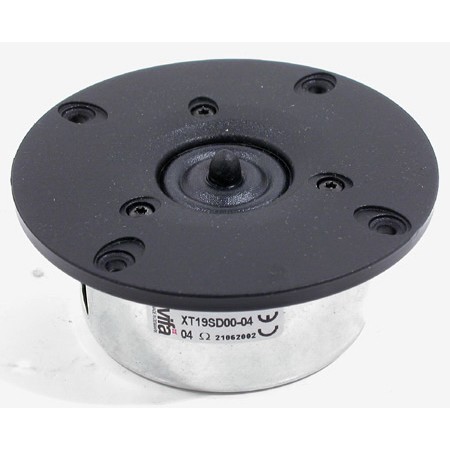
The second arrived LF. They turned out to be very decent midbass from the set of Soundstream Exact 5.3. Here you can read a little about them. It so happened that the "tweeters" during the installation burned down, and the lonely woofers themselves were not needed. 4-ohm 5.5 "midbass, fixed in a cast basket made of aluminum, were immediately purchased.

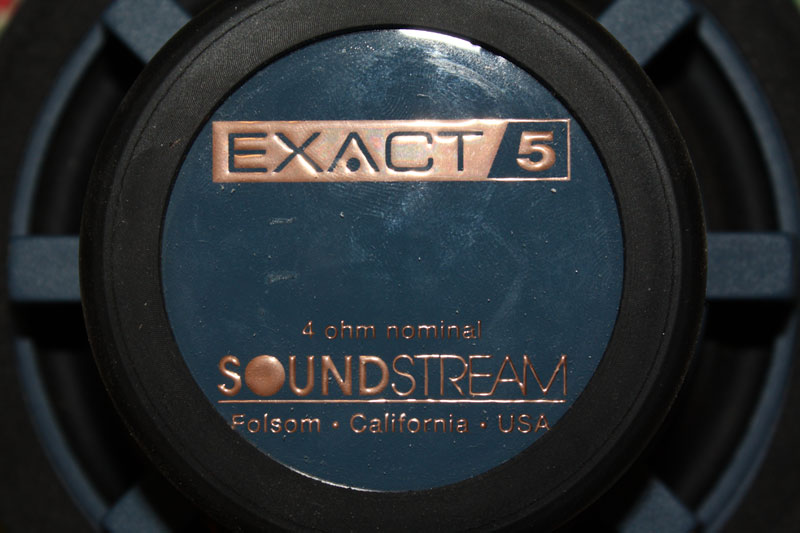
Now that the speakers are there, you can start creating acoustics.
Each option has its pros and cons. First, we must take into account the compactness of the columns themselves and the associated difficulties in the arrangement in conditions of limited space. And to mount outside does not make sense. Secondly, individual modules as independent components can be combined further, and it is also easier to repair in case of anything. And thirdly, active speakers are quite expensive. Because if you make a decent amplifier (and it happens one at a time in each case), then it will be more expensive than the acoustics itself. Besides, I already had an amplifier. But in any case, I am for the scheme - passive acoustics + amplifier, it is more versatile.
Determined with the speakers, it is now necessary to understand which case is optimal for them. Dimensions are calculated based on the characteristics of the woofer. There are no recommendations on the manufacturer’s website, since The speaker was intended primarily for car audio. There is no point in keeping special equipment for these purposes, unless it is your work. Therefore, an intelligent man with a special stand comes to the rescue. As a result of laboratory tests, we obtain the design size of the body 310 x 210 x 270 mm. In the process of measurements, the parameters of the phase inverter were also calculated.
By the way, many manufacturers on their sites publish the recommended size of the case for the speakers. When such information is available, it is logical to use it, but in this case I did not have such data, so I had to do laboratory research.
In my opinion, the most optimal material for the body is MDF. It is acoustically neutral, and also slightly better in performance than chipboard. Plywood is also good, but finding quality plywood is not easy, and it is more expensive and more difficult to process. A 22mm MDF sheet was chosen as the source material for the hull. In principle, the standard 18-20mm is quite enough, but I decided to do a bit with a margin. Stiffness is not superfluous.
One of the most important stages. Before you go for MDF, I advise you to decide on the design in order to immediately ask the seller to cut the sheet in parts, and there are always good machines with a precise and even cut at the normal sales point. At home, such a cut is difficult to get.
So, design. The columns should look at least as good as “industrial”, so that there is no feeling of a club of crazy hands. We do not only make high-quality, but also beautiful acoustics. In general, there are practically no beautiful, interesting and at the same time constructively simple acoustic systems. Beautiful acoustics makes Italian Sonus Faber, stunning in its beauty - Magico Mini. But all of them are made using precise machines, which, by definition, are not at home. As an option, you can order the case a good "cabinetmaker" with his hands and CNC. Such work will cost depending on where and what you order, from 10 000r. up to 30 000 rub. together with materials. If a specialist is good, then the speakers will look as good or even better as “store” ones. In this case, I decided that I would do everything myself. Therefore, we look at things realistically and make the construction without any bevels, curly sawings, etc. Those. it will be a parallelepiped. Estimated dimensions give a fairly pleasant proportion, and the proportion in design is half the battle.
What to design? Though I am connected with design by occupation, but I know 3D-packages, to put it mildly, superficially. At the same time, the program should be more engineering than the render. Specialized "Kady" for this purpose is too heavy and unnecessary. The solution was quickly found - Frivarny SketchUp is more than suitable for this purpose. It is so simple and intuitive that it was fully mastered in about an hour. He can do the main thing: quickly create any shapes, dimension, use simple textures. I believe that such a program is ideal for "home" purposes. In it, you can easily, for example, design a kitchen or even a small house.
Here is the case design:


The design is simple. Six walls, glued to each other. 2 front cutout for speakers. Behind 2 cutouts: under the phase inverter and under the terminal block. The rectangle 120x80 marks the place for the crossover. Inside the phase inverter is another wall in the width of the internal space, attached perpendicular to the notch:

Proceeding from the drawing, the scheme of cutting the sheet appears:

How are we going to finish the case? Pasting the film was immediately eliminated - the acoustics should look decent. As an option was considered painting. I refused this idea, because Such columns will not fit into every interior (at least they did not fit into the current one). I want more versatility. In this regard, natural veneer is more suitable. But acoustics completely plastered with veneer look boring. Search for a combined solution:

In general, the options are not bad in appearance, but they cause difficulties in a purely structural way. As a result, it was decided to trim the side walls with ash wood veneer, and cover the remaining 4 walls around the circumference with leather, more precisely with high-quality automotive leather. The squeak is beautiful in itself, but the woofer has a constructive pad on the front side of the case that will not look very nice. Therefore, it was decided to make for him an additional decorative lining (ring), which will press it to the body, and at the same time add beauty to the column itself. With the design and design decided.
Before proceeding to the next stage, I will outline which basic tools are needed for work:
- Circular.
- Jigsaw.
- Drill.
- Frazer.
- Grinding machine.
- Straight arms.
Without this set it is better to order the hulls to a good master.
So, we cut thebudget sheet MDF. I already wrote that it is better to cut on special machines - it is inexpensive, but it turns out for sure. But since I decided to make the body myself from and to, then for the purity of the experiment I sawed myself with a manual circular saw, and small pieces with a jigsaw from the guide. As expected the perfect cut did not work. After the cut, the pairs of walls (left-right, front-back, etc.) are set in pairs, adjusted by a polishing machine and / or an electric plane and checked for perpendicularity with a square. And later, during assembly, they are finally adjusted after gluing. A loss of 2-3 mm is insignificant. But still, I recommend sawing immediately “on the base”, save a lot of time.
The walls are glued together with PVA and tightened with screws. First, glue the body without the front wall.
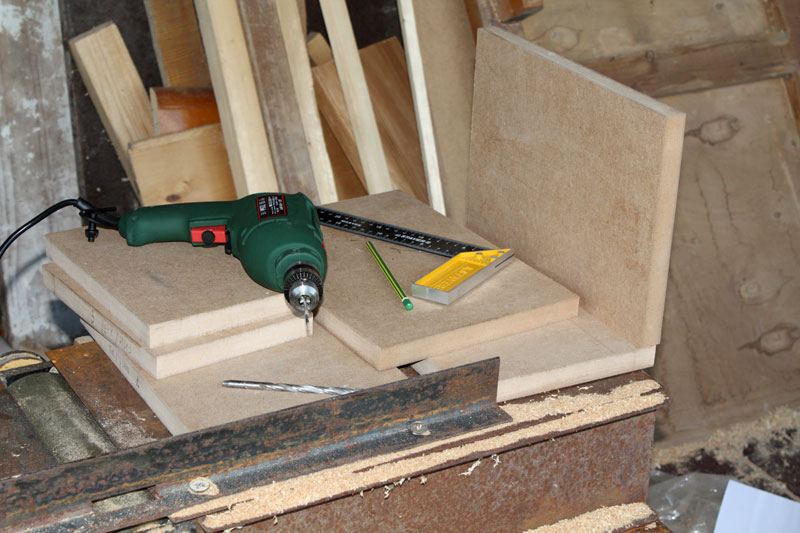


Next, sawing jigsaw hole bass reflex.
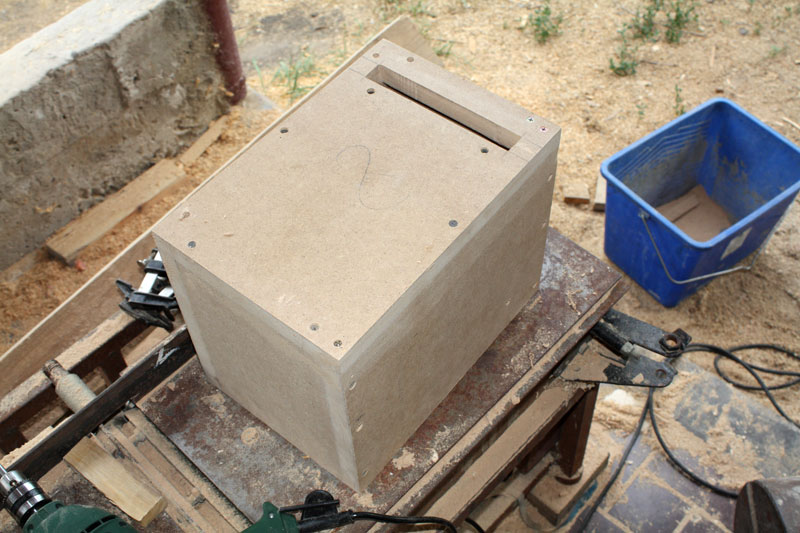
Now the hole for the terminal block, as well as the chamfer in order to "drown" it. Initially, the design of the terminal block was supposed to be placed below. But in the process it became clear that it would not be very convenient to mount a crossover in the center through the hole for the woofer, so I moved the hole under the cleat above and the space for the crossover below.

Before you “attach the cover”, you need to glue the inside with vibration-insulating material.
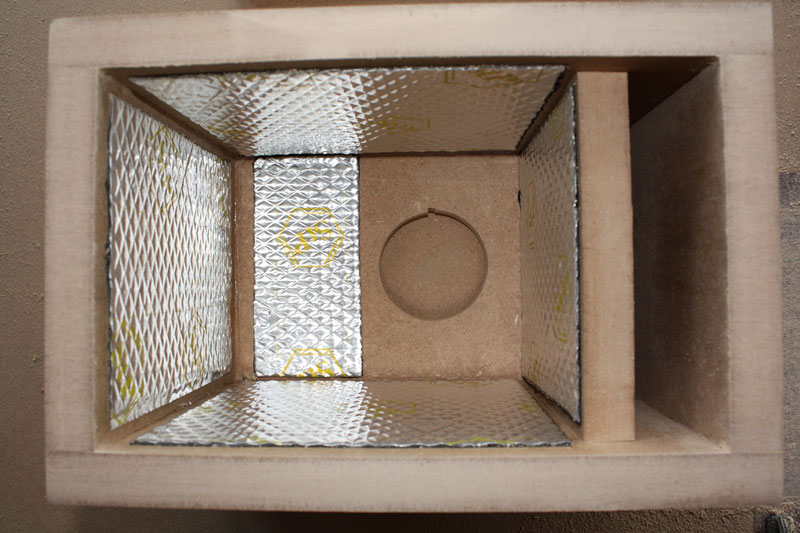
You can close the box.

Now one of the very crucial stages is the cut-out of the holes for the speakers on the front panel. I have already said that the ideal speaker system is single sideband. Why? Because the propagation of sound comes from one source to the listener without time mismatch due to the difference (scanty) in the distance that is when using a multi-band system. Therefore, the dynamics are best located as close as possible to each other. So the sound image is “denser”. We calculate the holes so that the distance between the edges of the speakers will be approximately 1 cm. The holes are sawn with a jigsaw with a circular guide.
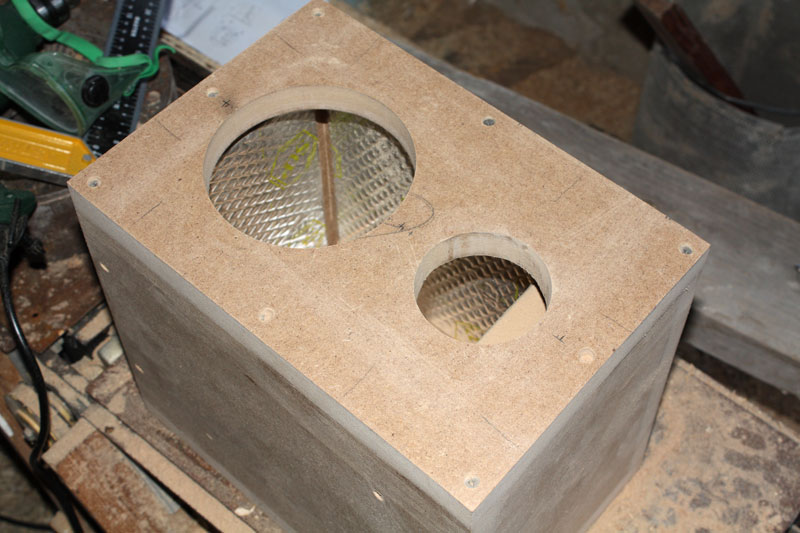
Speakers must be drowned. We attach the speakers and on their edge we outline the diameter for chamfering. The depth of chamfer measure on the lining of each speaker. The chamfer was filmed by a manual mill. The depth of the cut was set on the stop. No guides were used, neatly rounding off layer by layer to the line. For the "food" additionally drunk two "ear" under the terminals.

After the chamfers have been removed, we attach the terminal board and the speakers, after which we drill holes for future self-tapping screws with a thin drill bit. Without them, firstly, MDF itself can “uncover” itself when screwing in the screws, and secondly, it will be more difficult to put the speakers exactly at the final assembly. I thought for a very long time how to exhibit the dynamics relative to each other, I came to this scheme:
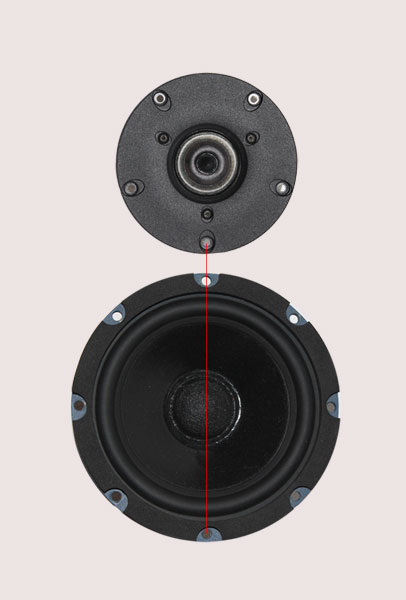
Screw holes on external surfaces must be repaired before final finishing. I used epoxy. To not wait until one surface hardens, taped each surface with tape and took over the next. When the epoxy had dried, it went through a grinding machine.
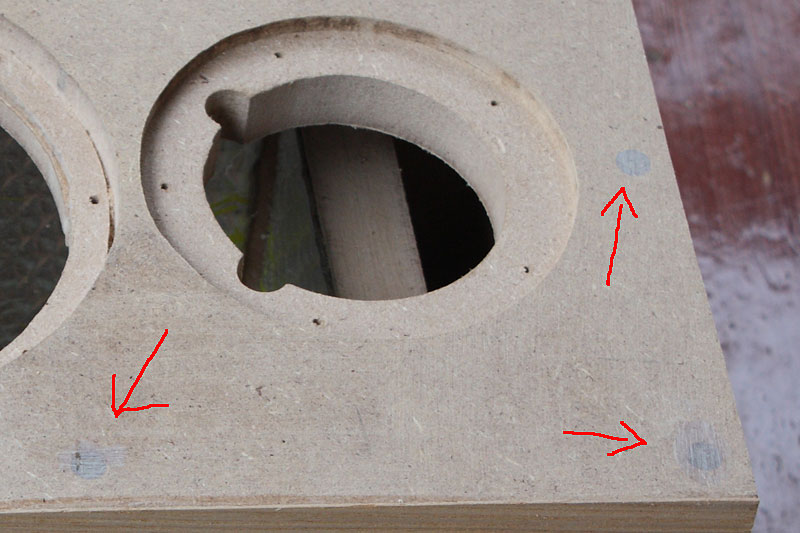
The veneer has remained since some ancient times, so it was not necessary to buy. The sheets were not wide, so a couple of sheets were picked up, fastened with adhesive tape and glued to the body. First one side, then the other.
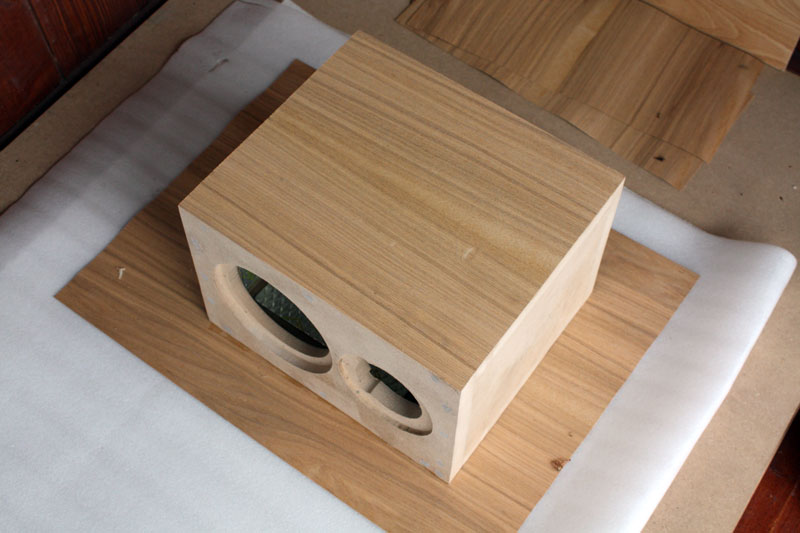
Veneer need to protect. I covered it with a clear yacht varnish.
Now you need to cover the case with leatherette. There are many options to do this. I decided to do the following. The strip is cut by 20 mm more than the width of the case and slightly longer than the circumference of the case. On each side bends 10 mm, the bend is glued on the "special adhesive 88". Then on the same glue the strip is glued on the body along the circumference. First, the bottom (partially), then the back wall, then the top, then the front and then the bottom. At the last stage, before the adhesive strip is clipped in place and butt-glued. I pasted all sides at once, i.e. I did not wait for each side to dry. After each side I made a short pause (the glue picks up quite quickly), and took up the next one.
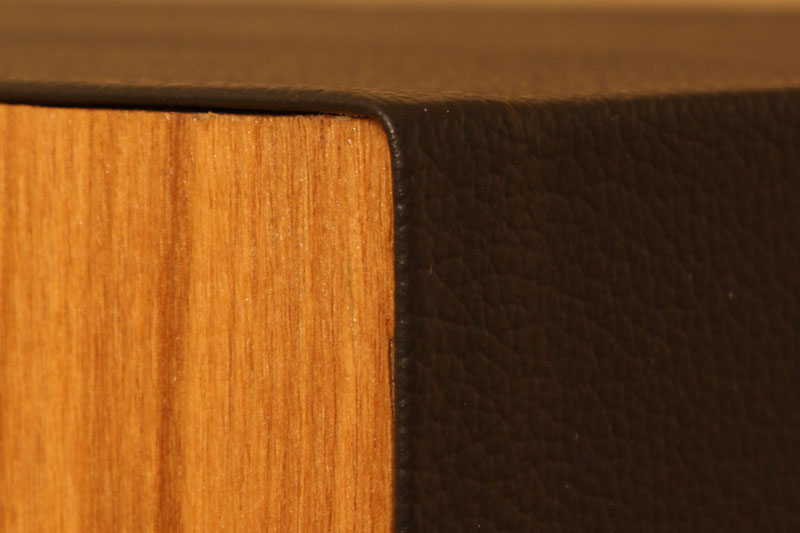
After everything is dry, the skin on the inverter bore is carefully cut and glued inward.
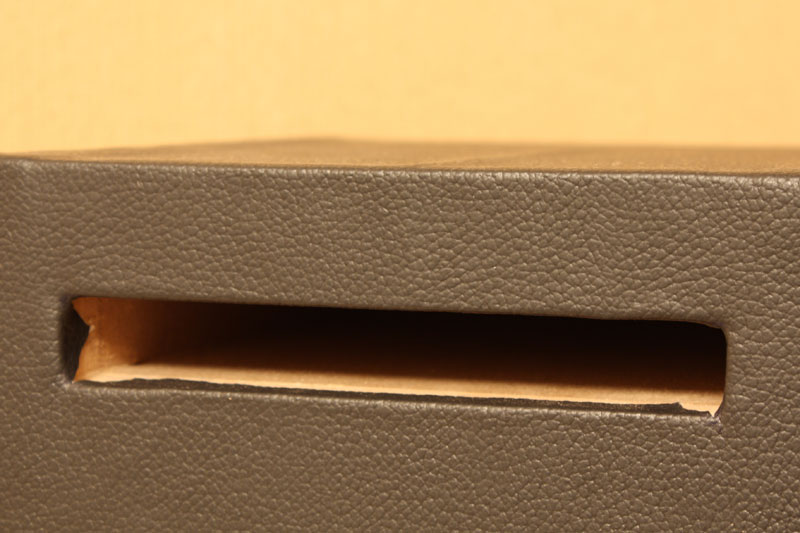
If you really want, then you can somehow improve the fazic.
Then holes are cut on the terminal strip, “woofer” and “squeaker”. The skin on the terminal strip and HF will sink down, so the diameter of the cutout can be left less than 5-10 mm. The skin on the woofer will be pressed against a decorative ring, so you need to trim so that it is not visible.
First of all we mount a crossover. Cross - self-made, on a good element base. Air-core coils, film capacitors for the beeper and MOX resistors are used. I myself did not solder it, but ordered sensible children.

By the way, many manufacturers sin by the fact that sometimes not very good crosses are put into even quite expensive acoustics. On the Internet, you can find a lot of "gutted" systems on this topic. Before you mount the cross, you need to solder three pairs of wiring: for the terminal block, woofer and treble. It turned out that you have to mount directly on the plate with vibration isolation. I considered that it was superfluous and dismantled it. Now you can fasten. As a substrate used a piece of packaging film from under some device.

Now solder the desired pair of wiring to the terminal block and fix it on the case. Terminal strip and speakers are screwed with decorative black screws with a head under the "asterisk". These screws screwed overlay on the "food", so it would be logical to use the same for the rest. The back wall is ready.
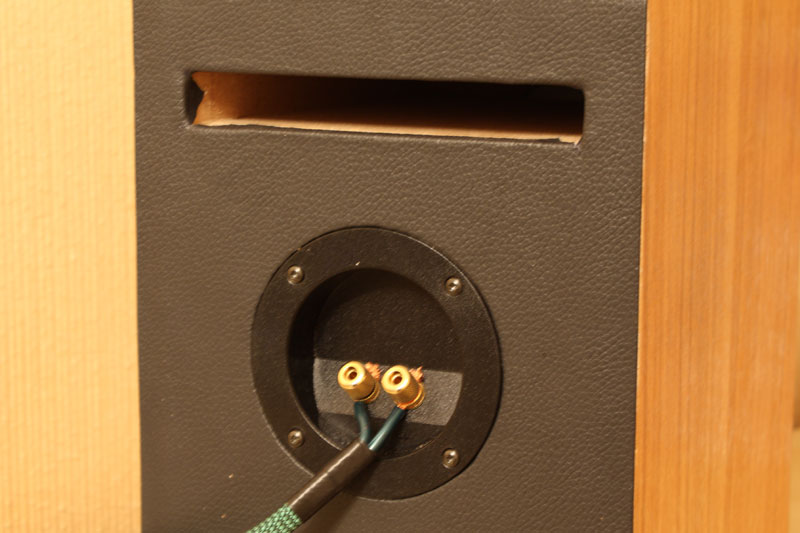
Before you mount the speakers, you must dampen the case with a special padding polyester. For these purposes, was used "wool" company Visaton. The synthetic winterizer is glued on the circumference along the walls.
From what dynamics to start in principle without a difference. I started with food. Solder the appropriate pair of wires from the cross, insert the speaker and fasten it with screws. Is done.

Midbass must be slipped under the skin, and press down with a decorative ring. Solder the remaining pair of wires and mount the speaker.
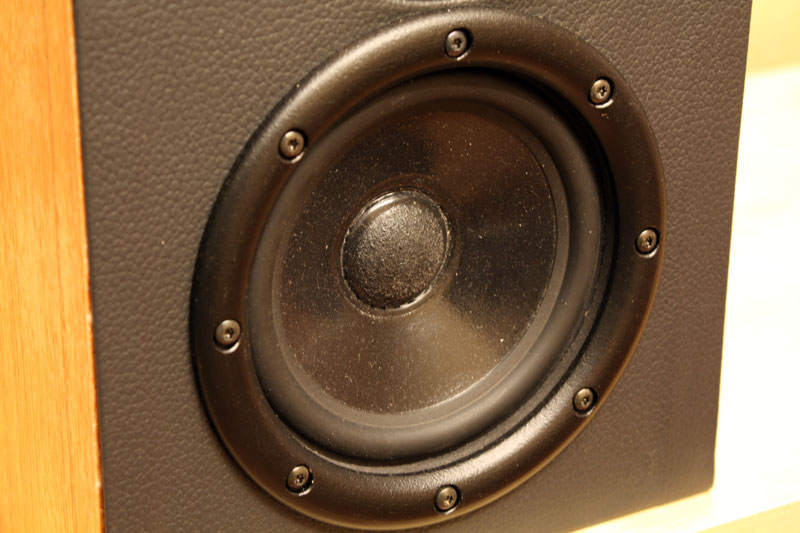
Everything? Everything. We screw the speaker cable to the terminal block and begin the tests.
The test system was produced in the following configurations:
1. Receiver Sherwood VR-758R + acoustics.
2. Computer + Unicorn (USB-DAC) + Self-made stereo amplifier + speakers.
3. Computer + E-mu 0204 (USB-DAC) + Sherwood VR-758R + acoustics.
A little about the configurations themselves. I personally think that at the moment the ideal version of a home music center is: computer + USB-DAC + amplifier + acoustics. The sound in the figure without distortion is removed via USB and goes to a high-quality DAC, from which it is transmitted to a high-quality amplifier and then to the acoustics. In such a chain, the number of distortions is minimal. In addition, you can use completely different phonograms: 44000/16, 48000/24, 96000/24, etc. Everything is limited by the capabilities of the driver and DAC. Receivers in this regard, less flexible and pre-morally outdated version. The size of modern hard drives allows you to store on them almost the entire media library. And the tendency to subscribe to Internet content can also eliminate this option, although this is not the near future and not for everyone.
I have to say that in all three configurations the acoustics sounded beautiful. I honestly did not even expect. Here are some subjective aspects.
1. Adequate and natural sound. What is recorded is reproduced. There is no bias in any direction. As I wanted.
2. Great sensitivity to the source material. All the flaws of sound recordings, if any, are well heard. Qualitatively mixed tracks listen perfectly.
3. Well readable bass for this size. Of course, organ music on shelves will not be fully appreciated (it is difficult to evaluate it in general with acoustics), but most of the material “digests” without problems. It is difficult to expect more from such babies.
4. Very good detail design. Hear every instrument. Even with a rich sound image and a decent volume, the sound does not move into the porridge (the amplifier plays an important role here).
5. I want to make it louder;) Ie acoustics do not yell, but play smoothly. Although there is also not a small merit of the amplifier itself, since with increasing load, a good amplifier maintains linearity.
6. From long listening does not have a headache. For me personally, this often happens, but here he plays all day long and that’s it.
7. Concerns about the incorrect panorama and the strong dependence of the sound on the position of the listener were not confirmed. As far as I know, the car speakers have a specific phasing of sound due to the peculiarities of the location of the speakers in the cabin. Namely, about this kit, I read that midbass in his plan is more universal. What actually confirmed. You can sit in the center in front of the speakers, you can stand next to them sideways - the sound is excellent. Dependence is, but very small.
As for the configurations themselves, the highest-quality sound was achieved with the second configuration.
First, a very high quality Unicorn DAC was used. Here you can read about it.
Secondly, the “self-made amplifier” is the know-how of one sensible Togliatti “soundman”. Here it is in a beautiful small aluminum case:
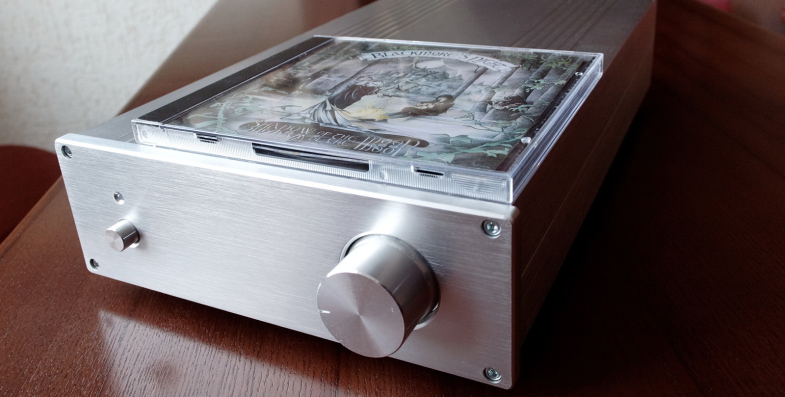

But the "gutted":

In a nutshell, we managed to find a circuit solution, in which the amplifier retains its characteristics, i.e. does not distort the sound at any (structurally permissible) volume. Very many amplifiers (even very expensive ones) suffer from this. It was amazing to listen to how such an amplifier animated many speakers, i.e.made them sound so they should sound. By the way, some industrial amplifiers were reworked according to this scheme (in particular, quite good and Xindak itself), and they had a “second wind”.
Compared acoustics with something else, you ask? Yes, for example with the ProAC Studio 110 - this is a high-quality bookshelf speakers, here's a little about them.. They compared and understood that they sounded exactly as good. The "proakov" may have a slightly lower dependence of sound on the listener's position due to the specific placement of the inverter and the "tweeter"; there somehow they all counted slyly. And the rest is absolutely no worse, even I personally liked my home-made products more, but we will write it down for subjectivity;) I also put on headphones (quite good Koss) and compared them over the panorama, tops and lows. Absolutely identical sound. Even on the bottom. In general, full of delight.
MF / LF speakers (pair): 3 000r.
Tweeters (pair): 3 000r.
Crossover (pair): 3 000r.
Sintepon: 160r.
Terminal (terminal): 700r.
Screws: 80p.
MDF sheet, 22mm: 2 750r.
Scotch: 30p.
PVA: 120r.
Spetskley 88: 120r.
Vibration insulation: 200r.
Figured ring-pad: 500r.
Cable: 500r.
Total: 14 160r.
Some of the materials were or were received free of charge; they were not included here.
In any more or less complex device or a complete functional system, absolutely everything is important. When it comes to the music system, a large number of factors affect the final result:
- The quality of the soundtrack.
- A device for playing phonogram.
- D / A converter.
- Signal amplifier.
- Wires.
- Speakers installed in the speaker enclosure.
- Properly designed for the speakers and well-assembled housing.
- Scheme and komplektuha for crossover.
This is a basic but not complete list.
It is wrong to assume that the main thing is the amplifier or the main thing - the wires, or the main thing - the speakers. Home music system is like an orchestra. And if in this orchestra someone is bad, and someone is brilliant to play, then in general it will turn out - medium. Or, as mentioned in a very accurate example: if you mix a barrel of shit with a barrel of jam, you get two barrels of shit.
There is another extreme. A good system is worth the fabulous money. So each component should cost half a million. And the phonograms must be exclusively in the Super Audio CD or on the company records. Type a closed society of elite audiophiles. Bullshit this all.
I came to the conclusion that it is quite possible to assemble our own relatively budgetary system, which is described in one word “Sounds”. And if, as a feature, it is better to use real-life solutions, which are many now, as a DAC or amplifier. That correctly made (independently or under the order) the speaker system, will sound better, than for the same money acquired "firm". Now almost all components can be ordered online. Moreover, many manufacturers publish enclosures for their respective speakers. There is a mass of software for calculating hull parameters. There are many specialized forums in the network, and offline there are people with hands. It’s certainly impossible to be an expert in everything. As in any field, the main thing is to know the general principles.
The article does not claim to be the ultimate truth, but I hope that my thoughts and my experience will be useful to someone else.

Upd.In comments, many ask about the amplifier. If anyone is interested, write in a personal, I will give the coordinates.
Upd2.The amplifier developer has got his own site - pvd-audio.com )
Number of lanes
In theory, the ideal system is one-way. But, like everything perfect, such a system does not exist in nature. Yes, there are very high-quality broadband speakers in the same Vizaton, but for some reason, all well-known manufacturers make dual-band shelf systems. And when it comes to the floor version, then 3 lanes are not uncommon. Here the question was not particularly - the classic two-way version: LF and HF.
')
Speaker Selection
The main requirement for the speakers is the optimal price / quality ratio. Those. it should not be “cheap” for 500r., but not a breathtaking “high-end” for $ 1000. Besides, I was in no hurry. The idea to collect the “shelves” with my own hands came quite a long time ago, and I threw the bait to my good friend, the “sick” sound in advance, with whom we have been constantly and fruitfully communicating on this topic for a long time.
The first appeared RF - Vifa XT19SD-00/04 ring-rad. These are high-quality 4-omnye "squeals", quite popular among audiophiles. Planned for one set, but for some reason did not go and were in my set.

The second arrived LF. They turned out to be very decent midbass from the set of Soundstream Exact 5.3. Here you can read a little about them. It so happened that the "tweeters" during the installation burned down, and the lonely woofers themselves were not needed. 4-ohm 5.5 "midbass, fixed in a cast basket made of aluminum, were immediately purchased.


Now that the speakers are there, you can start creating acoustics.
Active / passive?
Each option has its pros and cons. First, we must take into account the compactness of the columns themselves and the associated difficulties in the arrangement in conditions of limited space. And to mount outside does not make sense. Secondly, individual modules as independent components can be combined further, and it is also easier to repair in case of anything. And thirdly, active speakers are quite expensive. Because if you make a decent amplifier (and it happens one at a time in each case), then it will be more expensive than the acoustics itself. Besides, I already had an amplifier. But in any case, I am for the scheme - passive acoustics + amplifier, it is more versatile.
Calculation of body sizes
Determined with the speakers, it is now necessary to understand which case is optimal for them. Dimensions are calculated based on the characteristics of the woofer. There are no recommendations on the manufacturer’s website, since The speaker was intended primarily for car audio. There is no point in keeping special equipment for these purposes, unless it is your work. Therefore, an intelligent man with a special stand comes to the rescue. As a result of laboratory tests, we obtain the design size of the body 310 x 210 x 270 mm. In the process of measurements, the parameters of the phase inverter were also calculated.
By the way, many manufacturers on their sites publish the recommended size of the case for the speakers. When such information is available, it is logical to use it, but in this case I did not have such data, so I had to do laboratory research.
Body material
In my opinion, the most optimal material for the body is MDF. It is acoustically neutral, and also slightly better in performance than chipboard. Plywood is also good, but finding quality plywood is not easy, and it is more expensive and more difficult to process. A 22mm MDF sheet was chosen as the source material for the hull. In principle, the standard 18-20mm is quite enough, but I decided to do a bit with a margin. Stiffness is not superfluous.
Body design and design
One of the most important stages. Before you go for MDF, I advise you to decide on the design in order to immediately ask the seller to cut the sheet in parts, and there are always good machines with a precise and even cut at the normal sales point. At home, such a cut is difficult to get.
So, design. The columns should look at least as good as “industrial”, so that there is no feeling of a club of crazy hands. We do not only make high-quality, but also beautiful acoustics. In general, there are practically no beautiful, interesting and at the same time constructively simple acoustic systems. Beautiful acoustics makes Italian Sonus Faber, stunning in its beauty - Magico Mini. But all of them are made using precise machines, which, by definition, are not at home. As an option, you can order the case a good "cabinetmaker" with his hands and CNC. Such work will cost depending on where and what you order, from 10 000r. up to 30 000 rub. together with materials. If a specialist is good, then the speakers will look as good or even better as “store” ones. In this case, I decided that I would do everything myself. Therefore, we look at things realistically and make the construction without any bevels, curly sawings, etc. Those. it will be a parallelepiped. Estimated dimensions give a fairly pleasant proportion, and the proportion in design is half the battle.
What to design? Though I am connected with design by occupation, but I know 3D-packages, to put it mildly, superficially. At the same time, the program should be more engineering than the render. Specialized "Kady" for this purpose is too heavy and unnecessary. The solution was quickly found - Frivarny SketchUp is more than suitable for this purpose. It is so simple and intuitive that it was fully mastered in about an hour. He can do the main thing: quickly create any shapes, dimension, use simple textures. I believe that such a program is ideal for "home" purposes. In it, you can easily, for example, design a kitchen or even a small house.
Here is the case design:


The design is simple. Six walls, glued to each other. 2 front cutout for speakers. Behind 2 cutouts: under the phase inverter and under the terminal block. The rectangle 120x80 marks the place for the crossover. Inside the phase inverter is another wall in the width of the internal space, attached perpendicular to the notch:

Proceeding from the drawing, the scheme of cutting the sheet appears:

How are we going to finish the case? Pasting the film was immediately eliminated - the acoustics should look decent. As an option was considered painting. I refused this idea, because Such columns will not fit into every interior (at least they did not fit into the current one). I want more versatility. In this regard, natural veneer is more suitable. But acoustics completely plastered with veneer look boring. Search for a combined solution:

In general, the options are not bad in appearance, but they cause difficulties in a purely structural way. As a result, it was decided to trim the side walls with ash wood veneer, and cover the remaining 4 walls around the circumference with leather, more precisely with high-quality automotive leather. The squeak is beautiful in itself, but the woofer has a constructive pad on the front side of the case that will not look very nice. Therefore, it was decided to make for him an additional decorative lining (ring), which will press it to the body, and at the same time add beauty to the column itself. With the design and design decided.
Instruments
Before proceeding to the next stage, I will outline which basic tools are needed for work:
- Circular.
- Jigsaw.
- Drill.
- Frazer.
- Grinding machine.
- Straight arms.
Without this set it is better to order the hulls to a good master.
Cut
So, we cut the
Housing assembly
The walls are glued together with PVA and tightened with screws. First, glue the body without the front wall.



Next, sawing jigsaw hole bass reflex.

Now the hole for the terminal block, as well as the chamfer in order to "drown" it. Initially, the design of the terminal block was supposed to be placed below. But in the process it became clear that it would not be very convenient to mount a crossover in the center through the hole for the woofer, so I moved the hole under the cleat above and the space for the crossover below.

Before you “attach the cover”, you need to glue the inside with vibration-insulating material.

You can close the box.

Now one of the very crucial stages is the cut-out of the holes for the speakers on the front panel. I have already said that the ideal speaker system is single sideband. Why? Because the propagation of sound comes from one source to the listener without time mismatch due to the difference (scanty) in the distance that is when using a multi-band system. Therefore, the dynamics are best located as close as possible to each other. So the sound image is “denser”. We calculate the holes so that the distance between the edges of the speakers will be approximately 1 cm. The holes are sawn with a jigsaw with a circular guide.

Speakers must be drowned. We attach the speakers and on their edge we outline the diameter for chamfering. The depth of chamfer measure on the lining of each speaker. The chamfer was filmed by a manual mill. The depth of the cut was set on the stop. No guides were used, neatly rounding off layer by layer to the line. For the "food" additionally drunk two "ear" under the terminals.

After the chamfers have been removed, we attach the terminal board and the speakers, after which we drill holes for future self-tapping screws with a thin drill bit. Without them, firstly, MDF itself can “uncover” itself when screwing in the screws, and secondly, it will be more difficult to put the speakers exactly at the final assembly. I thought for a very long time how to exhibit the dynamics relative to each other, I came to this scheme:

Screw holes on external surfaces must be repaired before final finishing. I used epoxy. To not wait until one surface hardens, taped each surface with tape and took over the next. When the epoxy had dried, it went through a grinding machine.

Finish
The veneer has remained since some ancient times, so it was not necessary to buy. The sheets were not wide, so a couple of sheets were picked up, fastened with adhesive tape and glued to the body. First one side, then the other.

Veneer need to protect. I covered it with a clear yacht varnish.
Now you need to cover the case with leatherette. There are many options to do this. I decided to do the following. The strip is cut by 20 mm more than the width of the case and slightly longer than the circumference of the case. On each side bends 10 mm, the bend is glued on the "special adhesive 88". Then on the same glue the strip is glued on the body along the circumference. First, the bottom (partially), then the back wall, then the top, then the front and then the bottom. At the last stage, before the adhesive strip is clipped in place and butt-glued. I pasted all sides at once, i.e. I did not wait for each side to dry. After each side I made a short pause (the glue picks up quite quickly), and took up the next one.

After everything is dry, the skin on the inverter bore is carefully cut and glued inward.

If you really want, then you can somehow improve the fazic.
Then holes are cut on the terminal strip, “woofer” and “squeaker”. The skin on the terminal strip and HF will sink down, so the diameter of the cutout can be left less than 5-10 mm. The skin on the woofer will be pressed against a decorative ring, so you need to trim so that it is not visible.
Final assembly
First of all we mount a crossover. Cross - self-made, on a good element base. Air-core coils, film capacitors for the beeper and MOX resistors are used. I myself did not solder it, but ordered sensible children.

By the way, many manufacturers sin by the fact that sometimes not very good crosses are put into even quite expensive acoustics. On the Internet, you can find a lot of "gutted" systems on this topic. Before you mount the cross, you need to solder three pairs of wiring: for the terminal block, woofer and treble. It turned out that you have to mount directly on the plate with vibration isolation. I considered that it was superfluous and dismantled it. Now you can fasten. As a substrate used a piece of packaging film from under some device.

Now solder the desired pair of wiring to the terminal block and fix it on the case. Terminal strip and speakers are screwed with decorative black screws with a head under the "asterisk". These screws screwed overlay on the "food", so it would be logical to use the same for the rest. The back wall is ready.

Before you mount the speakers, you must dampen the case with a special padding polyester. For these purposes, was used "wool" company Visaton. The synthetic winterizer is glued on the circumference along the walls.
From what dynamics to start in principle without a difference. I started with food. Solder the appropriate pair of wires from the cross, insert the speaker and fasten it with screws. Is done.

Midbass must be slipped under the skin, and press down with a decorative ring. Solder the remaining pair of wires and mount the speaker.

Everything? Everything. We screw the speaker cable to the terminal block and begin the tests.
Tests
The test system was produced in the following configurations:
1. Receiver Sherwood VR-758R + acoustics.
2. Computer + Unicorn (USB-DAC) + Self-made stereo amplifier + speakers.
3. Computer + E-mu 0204 (USB-DAC) + Sherwood VR-758R + acoustics.
A little about the configurations themselves. I personally think that at the moment the ideal version of a home music center is: computer + USB-DAC + amplifier + acoustics. The sound in the figure without distortion is removed via USB and goes to a high-quality DAC, from which it is transmitted to a high-quality amplifier and then to the acoustics. In such a chain, the number of distortions is minimal. In addition, you can use completely different phonograms: 44000/16, 48000/24, 96000/24, etc. Everything is limited by the capabilities of the driver and DAC. Receivers in this regard, less flexible and pre-morally outdated version. The size of modern hard drives allows you to store on them almost the entire media library. And the tendency to subscribe to Internet content can also eliminate this option, although this is not the near future and not for everyone.
I have to say that in all three configurations the acoustics sounded beautiful. I honestly did not even expect. Here are some subjective aspects.
1. Adequate and natural sound. What is recorded is reproduced. There is no bias in any direction. As I wanted.
2. Great sensitivity to the source material. All the flaws of sound recordings, if any, are well heard. Qualitatively mixed tracks listen perfectly.
3. Well readable bass for this size. Of course, organ music on shelves will not be fully appreciated (it is difficult to evaluate it in general with acoustics), but most of the material “digests” without problems. It is difficult to expect more from such babies.
4. Very good detail design. Hear every instrument. Even with a rich sound image and a decent volume, the sound does not move into the porridge (the amplifier plays an important role here).
5. I want to make it louder;) Ie acoustics do not yell, but play smoothly. Although there is also not a small merit of the amplifier itself, since with increasing load, a good amplifier maintains linearity.
6. From long listening does not have a headache. For me personally, this often happens, but here he plays all day long and that’s it.
7. Concerns about the incorrect panorama and the strong dependence of the sound on the position of the listener were not confirmed. As far as I know, the car speakers have a specific phasing of sound due to the peculiarities of the location of the speakers in the cabin. Namely, about this kit, I read that midbass in his plan is more universal. What actually confirmed. You can sit in the center in front of the speakers, you can stand next to them sideways - the sound is excellent. Dependence is, but very small.
As for the configurations themselves, the highest-quality sound was achieved with the second configuration.
First, a very high quality Unicorn DAC was used. Here you can read about it.
Secondly, the “self-made amplifier” is the know-how of one sensible Togliatti “soundman”. Here it is in a beautiful small aluminum case:


But the "gutted":

In a nutshell, we managed to find a circuit solution, in which the amplifier retains its characteristics, i.e. does not distort the sound at any (structurally permissible) volume. Very many amplifiers (even very expensive ones) suffer from this. It was amazing to listen to how such an amplifier animated many speakers, i.e.made them sound so they should sound. By the way, some industrial amplifiers were reworked according to this scheme (in particular, quite good and Xindak itself), and they had a “second wind”.
Compared acoustics with something else, you ask? Yes, for example with the ProAC Studio 110 - this is a high-quality bookshelf speakers, here's a little about them.. They compared and understood that they sounded exactly as good. The "proakov" may have a slightly lower dependence of sound on the listener's position due to the specific placement of the inverter and the "tweeter"; there somehow they all counted slyly. And the rest is absolutely no worse, even I personally liked my home-made products more, but we will write it down for subjectivity;) I also put on headphones (quite good Koss) and compared them over the panorama, tops and lows. Absolutely identical sound. Even on the bottom. In general, full of delight.
Material costing
MF / LF speakers (pair): 3 000r.
Tweeters (pair): 3 000r.
Crossover (pair): 3 000r.
Sintepon: 160r.
Terminal (terminal): 700r.
Screws: 80p.
MDF sheet, 22mm: 2 750r.
Scotch: 30p.
PVA: 120r.
Spetskley 88: 120r.
Vibration insulation: 200r.
Figured ring-pad: 500r.
Cable: 500r.
Total: 14 160r.
Some of the materials were or were received free of charge; they were not included here.
In custody
In any more or less complex device or a complete functional system, absolutely everything is important. When it comes to the music system, a large number of factors affect the final result:
- The quality of the soundtrack.
- A device for playing phonogram.
- D / A converter.
- Signal amplifier.
- Wires.
- Speakers installed in the speaker enclosure.
- Properly designed for the speakers and well-assembled housing.
- Scheme and komplektuha for crossover.
This is a basic but not complete list.
It is wrong to assume that the main thing is the amplifier or the main thing - the wires, or the main thing - the speakers. Home music system is like an orchestra. And if in this orchestra someone is bad, and someone is brilliant to play, then in general it will turn out - medium. Or, as mentioned in a very accurate example: if you mix a barrel of shit with a barrel of jam, you get two barrels of shit.
There is another extreme. A good system is worth the fabulous money. So each component should cost half a million. And the phonograms must be exclusively in the Super Audio CD or on the company records. Type a closed society of elite audiophiles. Bullshit this all.
I came to the conclusion that it is quite possible to assemble our own relatively budgetary system, which is described in one word “Sounds”. And if, as a feature, it is better to use real-life solutions, which are many now, as a DAC or amplifier. That correctly made (independently or under the order) the speaker system, will sound better, than for the same money acquired "firm". Now almost all components can be ordered online. Moreover, many manufacturers publish enclosures for their respective speakers. There is a mass of software for calculating hull parameters. There are many specialized forums in the network, and offline there are people with hands. It’s certainly impossible to be an expert in everything. As in any field, the main thing is to know the general principles.
The article does not claim to be the ultimate truth, but I hope that my thoughts and my experience will be useful to someone else.

Upd.In comments, many ask about the amplifier. If anyone is interested, write in a personal, I will give the coordinates.
Upd2.The amplifier developer has got his own site - pvd-audio.com )
Source: https://habr.com/ru/post/131791/
All Articles